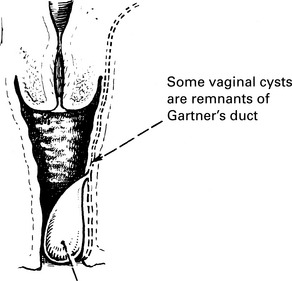Chapter 9 Diseases of the Vagina
Benign vaginal disease
Vaginal diseases can manifest as benign, premalignant or malignant conditions
Carcinoma of the vagina
Site and spread
Upper third: approximately same drainage as the cervix.
Middle third: any pelvic lymphatic channel may be involved.
| Clinical staging | Five-year survival rates (%) | |
|---|---|---|
| Stage I | Invasive. Confined to the vaginal mucosa. | 75–90 |
| Stage II | Invading paravaginal tissue, but not to the pelvic side wall. | 45 |
| Stage III | Extension to the pelvic side wall. | 30–40 |
| Stage IVa | Extension to mucosa of bladder or rectum. |  20 20 |
| Stage IVb | Extension beyond the pelvis. |  20 20 |
Plastic surgery of the vagina
2. The space between the urethra/bladder and the rectum is opened up. A finger in the anus helps the surgeon to avoid damaging the rectum.
















